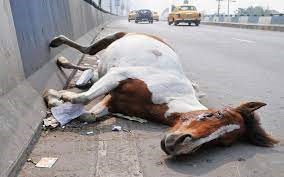After lumpy skin, now Glanders virus has hit Punjab. Within a few days, after Bathinda, this virus that sick horses fall sick with, has now taken Amritsar and Ludhiana under its ambit. As this dangerous virus spreads very fast, the Animal Husbandry Department has issued a notification declaring 5 km radius of the virus infected area in Bathinda and Ludhiana. The department has declared 25 km radius as a screening zone, whereas physical/sero surveillance has been started in the radius outside 25 km of screening zone.
In February 2023, the first case of Glanders was reported in Hoshiarpur’s BSF, but two new cases have been confirmed within a few days in May. Glanders is a dangerous disease, and when the virus is confirmed, there is no option but to kill the infected horse by giving it an injection. This is done so that the virus does not infect other animals or transmits in humans.
Caused by a bacterium called Barkholderia mallei, this disease usually directly attacks the lungs of horses. The horse gets high fever. Water starts flowing from the nose and there are blisters or sores inside the nose. Apart from this, there is swelling in the glands and there is a lump in the tail, throat, or lower part of the abdomen. Other animals are at a risk of infection. The Animal Husbandry Department has even instructed that people should not go to the area where there are infected animals. After the death of an animal from the virus, a 6 feet deep pit is dug and the animal is buried by adding lime and salt, as the virus is deadly.
After Hoshiarpur in February, the Glanders virus was confirmed in Lehra Mohabbat of Bathinda on 12 May, after which 16 days later on 29 May, the virus hit Bhamia Kalan of Ludhiana. The Punjab government has issued notification of these cases as per the rules, but in a few days, the second consecutive case increased concerns of the government.
As per officials, after declaring these cases under The Prevention and Control of Infectious and Contagious Diseases in Animals Act, 2009, a 5-km radius has been declared as an infected area. Along with this, preventive steps are being taken under the action plan issued by the Government of India regarding this disease.
Situation in
Haryana, Himachal and Rajasthan
Apart from Punjab, the outbreak of Glanders is also increasing in the neighbouring states of Himachal Pradesh and Rajasthan. Recently, after the death of three horses due to Glanders in Kullu’s Peej, two horses were killed by injection after the virus was confirmed. The horse virus has knocked in Rajasthan’s Jaipur, Jhunjhunu, Alwar and Bikaner. At the same time, horses have been infected in many districts of Haryana, after which the Animal Husbandry Department formed committees and started a campaign to make horse breeders aware in the area.
Over 100 big horse farms in Punjab
The spread of the virus in Punjab is worrying as there are over 100 big horse farms i.e. horse stables in the state. In these stables with 20 to 50 horses, most of the stables do the work of breeding and selling horses. This business contributes significantly to the economy of Punjab. According to Sumrinder Singh, a big horse breeder of Punjab, the spread of Glanders is a matter of concern for Punjab. “The Punjab government should take concrete steps for this. This is also because Glanders directly affects the business of horse breeders. The Punjab government should take some initiatives regarding the treatment of this disease at the primary level itself. Along with this, there should be an initiative to provide financial help to those horse breeders who are affected due to this virus and whose horses die,” he said.
Dr Rampal Mittal, Director, Animal Husbandry Department, Punjab, said: “The spread of Glanders is indeed a matter of concern. The Animal Husbandry Department is continuously monitoring the infected area of 25 km from the epicentre. Though cattle herders are constantly being made aware of, the way the disease is spreading, the department is also considering taking drastic steps like curbing the movement of animals. Prevention of this disease is possible only with public participation, so people should also follow the instructions of the Animal Husbandry Department and take the initiative to keep their horses away from contact with other animals.” The Punjab Animal Husbandry Department has issued a notification implementing the action plan issued by the Government of India regarding the control of Glanders and also launched an awareness campaign for horse breeders.

